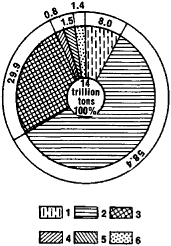*
*
*

Russian and Soviet geologists have made a substantial contribution to
knowledge of the processes of coal formation, the patterns of spatial
distribution of coal reserves, and other problems of coal geology. The first
specialists in the geology of coalfields were L. I. Lutugin and his students,
including V. I. Iavorskii, P. I. Stepanov, and A. A. Gapeev. In addition,
important work was done by M. A. Usov, Iu. A. Zhemchuzhnikov, I. I. Gorskii, G.
A. Ivanov, M. M. Prigorovskii, A. K. Matveev, and G. F. Krasheninnikov. The
development of coal geology in other countries is associated with the names of,
for example, the Germans H. Potonié, K. Naumann, M. Teichmüller, R. Teichmüller,
and E. Stach, the Britons M. Stopes, K. Marshall, and W. Francis, the Americans
R. Thiessen and D. White, the Dutchman D. von Krevelen, and the Czech V.
Havlena.
An analysis of the stratigraphic and paleogeographic distribution of coal
bodies in the earth was the basis of the theory of belts and major zones of coal
formation developed by P. I. Stepanov in 1937. He established a definite pattern
in the location of coal regions and coalfields of the same age: they are
arranged in latitudinal or submeridional belts associated with areas of the
earth’s surface where paleoclimatic and geotectonic conditions favored the
accumulation of coal. Making use of the stratigraphic distribution of world coal
reserves, P. I. Stepanov identified two peaks of coal formation: in the Upper
Carboniferous and Permian and in the Paleogene and Neogene. In addition, he
suggested that a third peak may have existed in the Jurassic and Lower
Cretaceous. Later investigators confirmed these patterns. The stratigraphic
distribution of world coal reserves, which in 1970 were estimated to total 14
trillion tons, is shown in Figure 2. The principal coal reserves in the USSR are
concentrated in Permian (48.5 percent) and Jurassic-Cretaceous (39 percent)
basins.
Coal formation is a regional geologic process that occurred on all continents
(Figure 3). Regions of continuous coal-bearing formations vary in area from a
few square kilometers to hundreds of thousands of square kilometers, and
thicknesses range from tens of meters to 20 km. The number of coal beds in the
formations ranges from a few to several hundred. According to current notions,
all the basic features of coal-bearing formations are determined by the
character and intensity of the oscillatory movements of the earth’s crust, in
close association with the history of structural development and with
paleogeography. These features include the thickness of the formation, the
spatial variation in composition and structure, the relationship with the
enclosing rocks, the degree of metamorphism, tectonics, and quantitative and
qualitative characteristics of coal-bearing capacity. Thus, coal-bearing
formations associated with foredeeps and with large inherited and superimposed
basins on a folded base (seeTECTONIC TROUGH) are
characterized by a large thickness, by a zonation of tectonic construction (from
strongly dislocated structures on the boundary with orogenic regions to less
disturbed structures in the central part of the basin and parts near platforms),
by a multiplicity of beds, by horizontal and vertical zonation in the
manifestation of regional coal metamorphism, and by a broad range of rank
varieties (from brown coals to anthracites). In the USSR, the coalfields
providing raw material for the by-product coke industry—that is, the Donets,
Kuznetsk, Karaganda, and Pechora fields—involve formations of this kind.
Large-scale coal formation processes are confined to platform regions. Thick
coal beds often accumulated in the coal-bearing formations associated with
postorogenic (Cheliabinsk and Turgai), inherited, and superimposed
(Kansk-Achinsk, Maikiuben’, and Southern Ural) basins. Thin coal-bearing
formations with low coal-bearing capacity are associated with platform
syneclises (Moscow and Irkutsk). The degree of coalification of the coals of
platform formations is low; brown coals and hard coals of varieties LF and G
predominate. Extensive coal formation did not occur in orogenic regions; coal
is, however, found in local areas where conditions were favorable for
continental sediment accumulation. Because of their complex tectonic structure,
such deposits are of limited industrial importance.
No comments:
Post a Comment